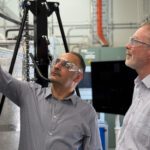Researchers from Curtin University have joined forces with astronomers from around the world in a major project to capture radiation bursts, following the rare merger of two neutron stars.
The merger was discovered on August 17 this year by gravitational wave detectors in the US-based Laser Interferometer Gravitational-Wave Observatory (LIGO) and the Italy-based Virgo detector, with Curtin’s Desert Fireball Network and the Murchison Widefield Array (MWA) radio telescope joining a global effort to record the bursts.
The Desert Fireball Network, led by Curtin University’s Professor Phil Bland, was the only facility of its kind on Earth to be looking in the right direction at the exact time of the neutron stars colliding.
“Colleagues from around 70 ground and space-based observatories – more than 3000 astronomers –worked together to point every possible telescope they had in the direction of the neutron star merger hoping to capture the bursts of radiation. It’s great that the Desert Fireball Network was able to assist with that effort, and provide data as-it-happened,” Professor Bland said.
“The Desert Fireball Network cameras that we have set up across Australia observe the whole sky, all night every night and in this case we got really lucky with one of our cameras in Western Australia in the right spot at the right time when the neutron stars went bang.”
“It was tremendously exciting to be part of something like this, and that our facility – designed for planetary science – was able to contribute to such an important event,” Professor Bland said.
A neutron star is formed when massive stars explode in supernovas. They are the smallest, densest stars known to exist with one teaspoon of neutron star material weighing more than a billion tonnes.
Also part of the search was the Murchison Widefield Array (MWA) radio telescope international consortium, led by MWA Director and Curtin University Associate Professor, Randall Wayth.
“Once we received notification of the event, the widefield nature of the MWA allowed us to search for radio bursts associated with the gravitational waves over a large area of sky, which meant we could join the rest of the world in being a part of this exciting cosmic event,” Associate Professor Wayth said.
“It also presented a great opportunity for us to use the MWA to test the methods of observations that we will use with the more powerful Square Kilometre Array, part of which will also be based in Western Australia.”
This discovery marks the first time scientists have been able to detect both gravitational waves (ripples in space and time) and light from the collision of two neutron stars at the same time, with the results announced overnight in the US and published in the journal Physical Review Letters.
“The data that were collected and captured is incredibly exciting in terms of our understanding of how the universe ticks and for Curtin researchers to be able to play a part in this reflects the high value of our planetary science and radio astronomy work,” Professor Bland said.
A dropbox link featuring video features and still images relating to the cosmic event are available here.
A joint media release by LIGO and Virgo is also available online here.


